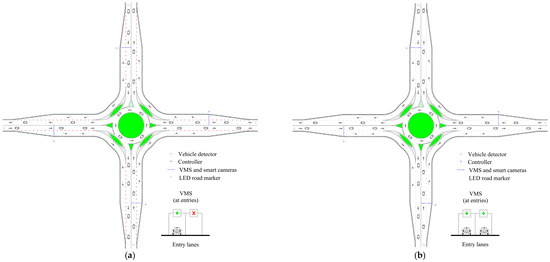Abstract
This paper presents the novel, smart, commutable, and self-regulated SSF-Roundabout as one of the potential solutions in the environment of smart mobility. The SSF-Roundabout implements traffic counting systems, smart cameras, LED road markers, and Variable Message Signs (VMS) on arms. Based on the instantaneous detection of the traffic demand level, vehicles can be properly channelled or not into right-turn bypass lanes, which the roundabout is equipped with in every arm, to guarantee the requested capacity, Level of Service (LOS), and safety. In total, fifteen very different layout configurations of the SSF-Roundabout are available. Several traffic analyses were performed by using ad hoc traffic engineering closed-form models and case studies based on many origin-destination traffic matrices (MO/D(t)) and proportions of CAVs in the traffic stream (from 0% to 100%). Simulation results demonstrate the correlation between layout scenarios, traffic intensity, distribution among arms, and composition in terms of CAVs and their impact on entry and total capacity, control delay, and LOS of the SSF-Roundabout. For instance, the right-turn bypass lane activation may produce an entry capacity increase of 48% and a total capacity increase of 50% in the case of 100% of CAVs in traffic streams.
1. Introduction
Transport safety is increasingly the focus of road design, vehicle driver assistance technology, and traffic flow regulation systems. From a design perspective, a proper solution to guarantee acceptable safety conditions in at-grade intersections is to use roundabouts. Several studies demonstrate that the crash rate of roundabouts is generally lower than that of other at-grade road intersection layouts [1]. Particularly, a meta-analysis shows that transforming existing cross-intersections into roundabouts can decrease fatal and injury accidents by 65% and 40%, respectively [2]. This is because, compared to other types of intersections, roundabouts reduce operating speeds, decrease the number of conflict points, and divide them into isolating zones [3].
Continuous innovation in communication driver assistance system technologies can produce increasingly better safety and efficiency conditions on public roads. The emergence of autonomous vehicles (AVs) and connected and autonomous vehicles (CAVs) has ushered in a new epoch of road transportation systems, offering future possible benefits for users and road operators. The presence of traffic flows composed of CAVs could determine increases in the capacity of both uninterrupted and interrupted flow roads. In particular, in roundabouts, autonomous and connected vehicles (CAVs) determine a potential increase in capacity, reducing wasted time, thanks to fewer critical intervals compared to those of human-driven vehicles (HDVs). This research aims to take advantage of this evolving technology to design a more efficient traffic management system for single-lane roundabouts equipped with right-turn bypass lanes, which can be made passable or not, depending on traffic conditions.
According to SAE international classification [4], autonomous vehicles (AVs) at levels 4 and 5 guide technologies (i.e., self-driving vehicles) and can drive without human involvement. Connected and autonomous vehicles (CAVs) are types of AVs able to communicate and exchange information about traffic and signals with nearby vehicles, road infrastructure, and cloud services. Finally, connected vehicles (CVs) can exchange information with other vehicles and physical infrastructure, but they are driven by a human user. Several scientific articles have examined the effect of CAVs on traditional and unconventional roundabouts [5,6,7]. Some research exhibits that roundabouts produce more efficient traffic conditions than signalized intersections for fleets formed of differences in percentages of CAVs in the total flow [8,9]. Important economic benefits accompany the safety benefits of CAVs due to the potential reduction in crashes today related to human errors during driving activities [10].
As for layouts and traffic regulation systems, nowadays the following roundabout types are available [11,12]: single- and multilane roundabouts, rotaries (an old-style large circular intersection where weaving sections along the circulating carriageway are required between intersection arms), signalized roundabouts, neighbourhood traffic circles, turbo-roundabouts, signalized turbo-roundabouts, spiral-marking roundabouts, and flower-roundabouts. Turbo roundabouts could be an alternative to two-lane roundabouts, especially to guarantee a high safety level, for example, in case of quite heavy cyclist/pedestrian traffic conditions.
Among all the roundabout layouts, the single-lane roundabout is safer due to the lower number of conflict points and vehicle speeds; nonetheless, its capacity is quite low [11]. Therefore, to improve capacity, single-lane roundabout designs have often included exclusive right-turn bypass lanes with different traffic regulation systems (controlled by stop, yield, or free-flow) that lie adjacent to the circulating ring. One or more legs can be equipped with a bypass right-turn lane, for instance, in the layout well known as Flower-Roundabout, which is a specific type of conventional roundabout with a ring lane, a lane at entries, and a right-turn bypass lane in each arm [12].
However, the use of bypasses can reduce the safety of the roundabout due to the increased exit and entry traffic conflict points. Furthermore, the fluctuations in traffic demand do not always make the use of bypasses necessary; hence, the idea of creating the SSF-Roundabout (acronym of Self-regulating Smart-Flower Roundabout), namely a novel smart and self-regulated roundabout with right-turn bypass lanes at each arm that can be activated or deactivated based on actual transport needs.
The SSF-Roundabout adopts vehicle counting systems, smart cameras, LED road markers, and Variable Message Signs (VMS) [9,13] on arms. Depending on the traffic intensity and distribution, the flows can be channelled appropriately or not into the right-turn bypass lanes to guarantee the requested capacity, level of service (LOS), and safety. The primary objective of this research is to describe and examine the performance implications of self-regulation SSF-Roundabout in different traffic conditions. Accident predictions are not included in this research and will be evaluated in future studies.
The research considers several traffic flow conditions and combinations of human-driven vehicles (HDVs) and CAVs [14,15].
It should be clarified that the authors support the use of the proposed SSF-Roundabout as a technological traffic management system for making safe roundabouts equipped with bypass lanes already in operation, which, as will be explained in the following sections, despite a greater capacity, give rise to a superior number of conflict points and therefore lower levels of safety compared to conventional single-lane roundabouts.
The rest of the paper is structured as follows. Section 2 briefly describes the SSF-roundabout concept. Section 3 and Section 4 explain the traffic engineering models used for traffic analysis. Section 5 and Section 6 briefly describe the input data used for the traffic simulation and discuss the main results regarding the SSF-Roundabout performance with and without CAVs. Conclusions are given in Section 7.
2. SSF-Roundabout: Main Characteristics
Single-lane roundabouts are extensively used thanks to their design simplicity, traffic regulation arrangements, construction and maintenance costs, and safety. Compared to other roundabout layouts, single-lane roundabouts guarantee considerable safety benefits because they are characterized by limited conflict points between different vehicle streams, and their characteristics and geometry encourage drivers to moderate their operating speeds. Reduced speeds at roundabouts have been proven to be the fundamental reason for improving safety. An additional circumstance is the lower number of conflict points compared to conventional intersections. Conversely, single-lane roundabouts offer fairly low-capacity values and, therefore, must be considered appropriate solutions only in the cases of moderate traffic demand levels.
Adding a right-turn bypass lane for approaches with heavy right-turn flows, which create imbalances for through movements, can provide a more balanced distribution of circulating flows and reduce the potential for failure to yield crashes at the downstream approach [16]. Therefore, to increase capacity, above all, in the case of a considerable percentage of right-turn maneuvers, additional bypass lanes can be installed, but the new layout (the so-called flower-roundabout, [12]) generates more conflict points (Figure 1) and, therefore, higher crash risks.
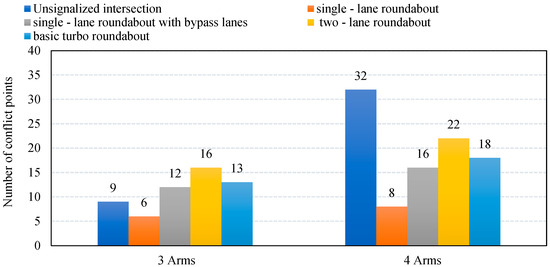
Figure 1.
Number of conflict points of different at-grade intersections.
More precisely, there are no weaving maneuvers in the circulatory carriageway, but only eight conflict points (4 diverging points and 4 merging points) which characterize a conventional single-lane roundabout. Bypass lanes generate additional conflict points (4 diverging and 4 merging points) positioned at a certain distance from the circulatory carriageway, where the effect on speed limitation is less noticeable. Therefore, on one hand, there is the benefit of eliminating weaving maneuvers on the ring, but on the other hand, there is the disadvantage of introducing diverging and merging conflict points away from the circulatory carriageway. A roundabout with four right-turn bypass lanes is characterized by 16 conflict points: 8 diverging points and 8 merging points (Figure 1).
In addition, right-turn bypass lanes increase conflict points between vehicles or between vehicles and pedestrians/cyclists [17,18,19]. Therefore, these additional lanes are suggested whenever cycle/pedestrian flows are low or absent.
In contrast, roundabouts with additional right-turn bypass lanes have much greater capacities than single-lane roundabouts but generate more conflict points and crashes (Figure 1). The SSF-roundabout proposed in this article combines the benefits of single-lane roundabouts with and without right-turn bypass lanes and, at the same time, mitigates their weaknesses (Figure 2). The SSF-Roundabout can be considered a smart and flexible road intersection that combines and amplifies the positive properties of roundabouts without and with right-turn bypass lanes while reducing their technical problems.
The main characteristics of the SSF-roundabout are explained below. In an SSF-roundabout, vehicle detectors and smart cameras installed at the arms measure and evaluate the traffic flows. Vehicle and queue detectors of arms must be placed at the proper distance from the circulating lanes (e.g., 35 m for a 50 km/h speed limit and 40 m for a 60 km/h speed limit) [19,20]. As a function of the intensity and distribution of traffic flows at the intersection, the configuration of each entry can be automatically and in real-time adjusted because bypass lanes can be active or inactive, resulting in different layout scenarios as summarized in Table 1.

Table 1.
Different layout scenarios based on the activation or inactivation of right-turn bypass lanes (Ac: right-turn bypass lane active, I: right-turn bypass lane inactive).
Real-time dynamic reconfiguration can be considered one of the most essential innovations of SSF-roundabout. This adaptability enables the system to optimize capacity and safety simultaneously, allowing it to respond to fluctuations in traffic demand at different approaches. As a result, it can significantly reduce localized peak congestion and delay the propagation of traffic queues through upstream and downstream links, particularly in mixed traffic environments where the penetration rate of CAVs changes rapidly.
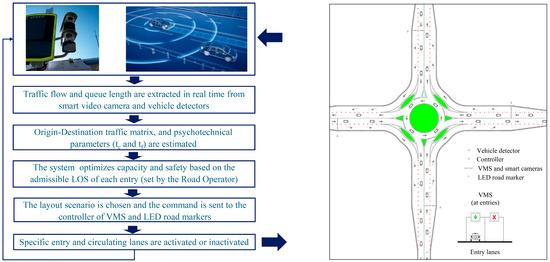
Figure 3.
How the SSF-roundabout works.
- traffic flow and queue length are estimated in real-time from sensors (i.e., smart cameras and vehicle detectors);
- The origin–destination traffic matrix MO/D(t) at a certain time instant t is evaluated, and the psycho-technical users’ parameters (critical time and follow-up time) are estimated;
- The controller system decides if a bypass lane must be active to produce an admissible LOS value (set by the road operator) at the observed arm;
- The operative layout scenario is selected according to the fifteen configurations summarized in Table 1;
- The controller communicates to the neighbouring VMS and LED road markers to indicate to users of certain arms if the right-turn bypass lanes are activated or not;
- The operative layout scenario is revised every few seconds and may switch based on the estimated current origin–destination traffic matrix MO/D(t) and admissible LOS;
- If the traffic demand is relatively low, LED road markers, and VMS direct users only to the circulating carriageway. In this situation, the SSF-roundabout works as a single-lane roundabout (Figure 2a), and the corresponding layout reduces the conflict points (in total 8, Figure 1) and the crash risk. Instead, when traffic flows are high, the activation of right-turn bypass lanes is forced (Figure 2b), resulting in an increase in capacity and a reduction in delays and queues.
Considering the positive and negative aspects highlighted for roundabouts equipped with bypass lanes, the SSF-roundabout can be considered primarily a technical solution to convert unsafe roundabouts with right-turn bypass lanes already in operation. More precisely, if implemented in existing roundabouts, the proposed regulation system of SSF-roundabout allows the bypass lanes to be activated only when traffic demand levels justify their use. In this way, for much of the time, the roundabout with bypass lanes operates like a single-lane roundabout, with the bypass lanes activated only during traffic peaks.
3. Models for the Performance Analysis
The performance analysis of roundabouts requires the estimation of several Measures of Effectiveness (MOEs), including entry capacity, degree of saturation, delays, queues, and Level of Service (LOS). However, capacity is the primary traffic parameter, and the other MOEs are correlated to the entry capacity. In traffic engineering, different capacity types can be established for roundabouts, including the following ones [21]:
- Entry capacity (EC) is the smallest entering flow value from an entry that generates the persistent presence of vehicles queuing up to enter the circulating lane;
- Simple Capacity (SC) is the first value of capacity that is reached at one entry for a steady increase in the traffic demand and for a prefixed proportion of the traffic streams at the road intersection;
- Total Capacity (TC) is the sum of the flows entering from entries, obtained in specific traffic conditions of the roundabout, for instance, when at least one entry lane is in saturation.
3.1. Entry Capacity Models
Simple Capacity and Total Capacity can be assessed starting from the Entry Capacity. Therefore, entry capacity is the key factor for producing the performance analysis of roundabouts and is assessed with analytical models or traffic simulations. Usually, entry capacity is evaluated by using the so-called gap acceptance theory, whose general relation is as follows:
where Ci is the entry capacity of the i-th arm of the roundabout, Qc,i is the circulating flow in front of the i-th arm, tc and tf are the users’ critical gap and follow-up time, respectively. TC and tf are essential to obtain precise and consistent traffic analysis results and are usually evaluated with specific estimation models, including the Drew, Raff, Ashworth, and Miller techniques [21]. One of the most used entry capacity models is that suggested by the HCM Manual, which is derived from the following Siegloch model [22]:
with
Ci = f(Qc,i, tc, tf)
The continuous real-time estimation of driver behaviour parameters (or psycho-technical parameters) such as critical gap and follow-up time (tc and tf) can be utilized to transition from static to dynamic traffic modelling. Moreover, adaptive capacity prediction can be achieved by focusing on the combined effects of driver behavioural changes and the integration of CAVs into these estimations. In future implementations, machine learning models trained on multi-source traffic datasets could further enhance these predictions by incorporating user-specific response profiles.
Figure 4 represents the entry capacity as a function of Qc,i, tf, and tc. It is immediately clear that tf and tc greatly impact the entry capacity. This is why it is fundamental to assume proper and consistent values of tf and tc established through a statistical study of traffic data and users’ behaviours. From this point of view, generally, once tf and tc are estimated, their values are considered constant over time. In real traffic conditions, since tc and tf depend on the behaviour of users, they may change continuously at any interval. Consequently, the capacity and other MOEs change accordingly, even if the MO/D(t) matrix could remain quasi-constant. Consequently, using stationary values for tc and tf can give inaccurate capacity, delay, and LOS forecasts. From this perspective, the implementation of smart cameras in the SSF-roundabout and specific techniques for vehicle identification and tracking could allow continuously updated estimates of the values of the psychotechnical parameters tf,k and tc,k at every generic time interval Dt,k by using techniques like Drew, Raff, Ashworth, and Miller methods. Therefore, following this procedure, the accurate capacity and LOS evaluation can be performed in the SSF-roundabout.
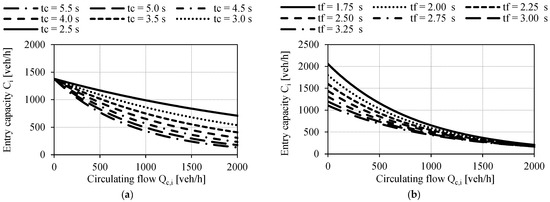
Figure 4.
Entry capacity variations as a function of circulating flow, critical gap, and follow-up time. (a) tf = 2.61 s and tc = 2.5–5.5 s; (b) tc = 5 s and tf = 1.75–3.25 s.
This study used the HCM method [23] to analyze the SSF-roundabout. According to HCM, the capacity Ci of an entry lane conflicted by a single circulating lane is obtained with the following relationship:
3.2. Capacity of the Bypass Lanes
Right-turn bypass lanes can be categorized based on the flow regulation systems as follows:
- bypass lanes controlled by “Yield” signs;
- bypass lanes controlled by “Stop” signs;
- bypass lanes with a “Free flow” control system, i.e., equipped with an acceleration road segment.
In particular, for the right-turn bypass lanes controlled by Yield or Stop signs, the right-turn traffic stream of the bypass must give way to the traffic stream exiting from the roundabout carriageway on the subsequent arm. Instead, for the free-flow bypasses, the lane length must permit the vehicles’ acceleration and then entry into the stream of the exit lanes coming from the circulating carriageway.
Numerical examples on the calculation of the right-turn bypass lanes capacity are described in [18,21,23].
- A.
- Bypass with a Stop regulation system
Under the typical hypothesis of Poissonian vehicle arrival distribution law at the right-turn bypass, with any service time s and vehicle headway τ (on the lane exiting from the roundabout) distributed according to a Gamma random variable with parameter K, the capacity of the bypass lane at the i-th arm, estimated at the stop line section can be estimated with the relationship of the queue theory as follows:
in which
where
- Q = Qc,b,i conflict flow of the bypass lane [veh/h];
- K = 1 if 100 ≤ Q = Qc,b,i ≤ 300 veh/h;
- K = 2 if 400 ≤ Q = Qc,b,i ≤ 800 veh/h;
- K = 3 if 800 ≤ Q = Qc,b,i ≤ 1500 veh/h;
- K = 4 if 1500 < Q = Qc,b,i ≤ 1800 veh/h
- T = critical gap (s);
- V is the mean speed of the vehicle belonging to the flow ;
- a is the acceleration by which the vehicles of the bypass (flow ) merge into the flow ;
- l is the safety time interval between the successive vehicles of this flow that can be assumed to be equal to the perception-reaction time of users (l = 1 s).
The vehicle speed V can be estimated with the model described in the NCHRP Report 672 [24] and depends on the deflection radius of the vehicle trajectories during the entering, circulating, and exiting maneuvers. For T = 5.5 s from Equations (6) and (7), we can obtain the stop-controlled bypass lane capacity as follows:
Under the hypothesis of vehicle arrival and headway distribution laws mentioned above, it is possible to calculate the average number of queuing vehicles E[q] and, consequently, to establish the length of the storage section Ls of the bypass to allow the vehicle queue (Figure 5a):
Ls = γ·E[q]
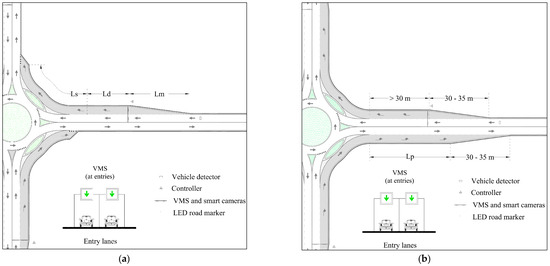
Figure 5.
(a) Right-turn bypass layout regulated [25] with a stop or yield sign; (b) layout of a free-flow bypass lane.
in which: Q = Qc,b,i; Qb,i = flow in the bypass lane; V[s] = service time variance; E[w] = average queuing time; γ = average space distance between couples of subsequent vehicles (γ = 5.50 m).
The layout of Figure 5a is suggested in some international guidelines [25]. However, for this scheme, some safety issues can be identified due to backwards visibility from the stop (or yield) position that is severely occluded, as the vehicle leaving the roundabout cannot be seen by the driver who must yield.
Figure 6a shows the variations in the number of vehicles queuing for the stop-controlled bypass lane of the i-th arm as a function of the bypass flow rate and the exit lane flow rate in the destination arm (i + 1-th) (), based on the average exit flow speed V, assumed to be V = 30 km/h. Using Equations (6)–(13), it can be deduced that as V increases, the queue length increases.
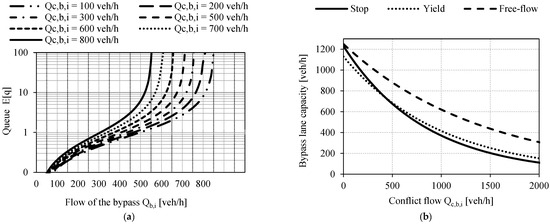
Figure 6.
(a) Values of queue for a right-turn bypass lane controlled by Stop sign (V = 30 km/h). (b) Values of the bypass lane capacity.
- B.
- Bypass with a Yield regulation system
In the case in which a yield signal regulates the right-turn bypass lane, its capacity can be estimated with the following expression [24]:
- C.
- Free-Flow Bypass Lane
In the case of free-flow bypasses, vehicles do not have to stop before merging onto the destination branch. For this type of bypass, the capacity can be calculated using the expression following [25,26]:
Figure 6b shows the capacity comparison of the three types of right-turn bypass lanes. As is evident, the free-flow bypasses give rise to the highest capacities, while the bypasses regulated with Stop or Yield signs are substantially equivalent to each other.
4. Effect of CAVs on the SSF-Roundabout Performance
Several studies carried out with analytical models and traffic microsimulation software demonstrate that the future presence of CAVs in traffic flows could generate the improvement of roundabout performances in terms of MOEs at the same levels of traffic demand. Furthermore, the potential advantages in terms of capacity, delay, queue, and LOS will increasingly grow as the percentage of CAVs in traffic flows increases. The advantage of CAVs compared to current HDVs lies in their automated driving system and reduced reaction times, which allow for the implementation of smaller time headways between vehicles compared to those currently measurable in the drivers of HDVs.
4.1. Entry Capacity Model
To estimate the effect of CAVs on the operating conditions of roundabouts, reference can be made to the model proposed by the HCM, which suggests using adjustment factors for the entry capacity when CAVs are present. The entry capacity model has the following expression [23]:
where Ce,i is the entry lane capacity of the i-th arm adjusted for CAVs presence, A is the intercept parameter, B is the slope parameter, Qc,i is the conflicting flow rate (i.e., the circulating flow in front of the i-th arm), fA is the adjustment factor for the intercept parameter, and fB is the adjustment factor for the slope parameter. Table 2 exhibits fA and fB values to adopt for a given roundabout layout in terms of the number of entries and conflicting circulating lanes. The capacity adjustment factors for CAVs suggested by HCM [23] were originally obtained with microscopic traffic analyses. For more information about the procedure to adopt for calibrating capacity formulas, the interested reader may consult [21,23].

Table 2.
Entry capacity modification factors for CAVs’ presence at roundabouts [23].
4.2. Total Capacity, Delay, Queue, and LOS
To analyze the general traffic performance of SSF-roundabout (Figure 2), first, counterclockwise labelling of each arm can be adopted by using a step-by-step process, as follows:
- Step a: The symbol “i” is assigned to the arm South;
- Step b: The symbol “i” is assigned to the arm East;
- Step c: The symbol “i” is assigned to the arm North;
- Step d: The symbol “i” is assigned to the arm West.
Considering that the traffic demand may change, at the generic time instant t, the traffic demand for a roundabout with four arms in terms of origin–destination traffic matrix MO/D(t) can be written as follows:
or in the vector form as follows:
in which Qij(t) represents the traffic volume (veh/h) that enters from the generic arm “i” and exits from the generic arm “j” of the SSF-roundabout.
MO/D(t) = [Qij(t)], i, j = 1, 2, 3, 4.
With Equation (18), the flow components can be computed as described below:
Neglecting the traffic flow component originating and destined to the same node (i.e., the component of the type Qi,i), the previous relation can be simplified as follows:
The total entry flow Ei originated from the arm i-th as follows:
where is the proportion of the right-turn flow that uses the bypass lane under consideration. Considering that U-turn maneuvers are generally absent, the flow component originated in “i” and with destination “i” is generally close to zero (). Therefore Equation (23) can be rewritten as follows:
Considering that each leg of the SSF-roundabout is equipped with one right-turn bypass lane, the capacity of the entry lane Ce,i and the capacity of the right-turn bypass lane Cb,i can be estimated as follows:
where Qc,i is the conflicting flow (i.e., the circulating flow) for the entry i-th and Qc,b,i is the conflicting flow for the vehicles travelling on the bypass and corresponds to the exit flow of the arm i + 1.
The coefficients A* and B* have the same meaning as the coefficients A and B explained above and their values are given in Table 2.
After having calculated the capacity values, the degrees of saturation can be obtained as follows:
Generally, the values of the degree of saturation differ, and consequently, the capacity, control delays, and LOS of the entry lane and the bypass lane at the i-th arm also vary. Therefore, the capacity Ci of the traffic stream originating from the arm i-th can be estimated as follows:
Taking into consideration the expressions of Qe,i and Qb,i, Ci can be rewritten as follows:
Assuming fA* = fA and fB* = fB the final relation of Ci is obtained for the case in which the bypass lane is activated as follows:
Consequently, the capacity of each arm cannot be estimated as a simple sum of the entry lane capacity and the bypass capacity: Equation (33) demonstrates that it depends on several traffic flow factors.
If the bypass lane is deactivated, the prevision equation can be simplified because it results d = 0, Qb,i = 0, and therefore the capacity is:
Lastly, in the case of unsaturated traffic conditions, the total capacity CT can be obtained as the sum of the capacity Ci of all the N arms as follows:
Control delay estimation is essential for identifying the level of service (LOS). It is well known that when the flow of a lane reaches or exceeds the capacity, significant delays, queues and congestion can occur. According to the HCM manual [23], the control delay of the two lanes of the i-th arm can be estimated with the following expressions:
in which De,i and Db,i are the average control delay of the entry lane and the bypass lane of the i-th arm (s/veh), and T is the time interval period.
The control delay DE,i for the i-th approach with two lanes (entry lane and right-turn bypass lane) is calculated by computing a weighted average of the delay for each lane on the approach, weighted by the flow of each lane, namely:
finally, the control delay for the entire SSF-roundabout is estimated as follows:
The level of service (LOS) is assumed from control delay, considering the values summarized in Table 3.

Table 3.
Level of service (LOS) as a function of control delay.
The 95th percentile of the queue for a given lane on an approach is calculated with the following expression [23]:
where Nq,e,i and Nq,b,i are the 95th percentile queue (veh) of the entry lane and the bypass lane of the i-th arm, and T is the analysis period (h) (T = 1 for a 1 h analysis; T = 0.25 for a 15 min analysis).
The mean queue for the i-th arm can be obtained as follows:
For instance, Figure 7 displays the surface obtained with the values of the control delay DE and mean queue Nq,E,i of an entry into the SSF-roundabout with a stop-controlled bypass lane, as a function of the saturation degrees xe,i = Qe,i/Ce,i and xb,i = Qb,i/Cb,i, (for Ce,i = 400 veh/h and Cb,i = 500 veh/h, d = 1).
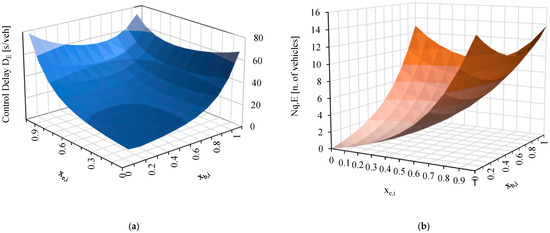
Figure 7.
Entry control delays (a) and mean queues (b) at the i-th arm of the SSF-roundabout with the stop-controlled right-turn bypass lane active (for Ce,i = 400 veh/h and Cb,i = 500 veh/h, δ = 1) and 0% of CAVs.
5. Traffic Simulations
Numerous traffic simulations related to an extra-urban intersection were performed (without pedestrian flows) to examine the functionality of the SSF-roundabouts in detail. Two test matrices of traffic distribution ρi were considered (Table 4):

Table 4.
Traffic distribution matrices. (a) ρ1; (b) ρ2.
- traffic distribution matrix ρ1, represents an equal distribution of the traffic into the SSF-roundabout: 33.3% of the entering flow crosses the roundabout, 33.3% turns right, and 33.3% turns left;
- traffic distribution matrix ρ2 represents the condition that most users turn to the right: for each entry, 15% of the entering flow crosses the SSF-roundabout, 70% turns right, and 15% turns left.
- Clearly, this article only considers two traffic distributions for brevity, and therefore, they should be regarded as illustrative. Furthermore, the two matrices represent two extreme and unlikely cases of traffic distribution on a roundabout, which varies continuously over time. However, using these distributions makes it possible to clarify how to apply the performance models explained in the previous sections. The interested reader will then be able to iterate the procedure proposed in this research with any other traffic distribution specific to each real case.
However, for the two traffic distribution matrices under consideration, entry flow rates Ei(t) to each arm of the SSF-roundabout have been increased from the minimum value of 0 veh/h to the maximum value, which produces a circulating flow of 1800 veh/h (Equation (43)), here assumed as the capacity of the circulating lane as evaluated in [21]. In addition, we considered several proportions of CAVs in the traffic stream (from 0% to 100%) and several values of (from 0 to 1). In particular, the condition = 0 represents the scenario in which bypass lanes are inactive (Figure 2a); instead, 0 < < 1 indicates the scenario in which bypass lanes are active (Figure 2b), but the right-turn flows use the bypasses in the proportion .
Finally, = 1 denotes the condition in which bypass lanes are active (Figure 2b), and 100% of vehicles that perform the right-turn maneuver use the bypass lanes.
With respect to Figure 2, the following notations are used for the analysis:
- The number 1 is assigned to the arm South;
- The number 2 is assigned to the arm East;
- The number 3 is assigned to the arm North;
- The number 4 is assigned to the arm West.
MO/D(t) = [Qij(t)] = Ei(t)∙ρi
For each traffic condition represented by an assigned MO/D(t) matrix (Equation (43)), the flow components at the SSF-roundabout can be calculated by using Equations (44)–(48) and then the entry capacity Ci, the Total Capacity CT, the control delay DE,i and the intersection delay DT are evaluated by Equations (33), (35), (38) and (39), respectively.
6. Results
For the traffic distribution matrix ρ1 and the scenario in which right-turn bypass lanes are inactive (scenario S1 of Table 1 and Figure 2a), which under the functional point of view corresponds to a single-lane roundabout, Figure 8 and Figure 9 show the capacity and delay values estimated for each arm and for the whole intersection as a function of the circulating flow Qc,i and the total inflow , respectively, and under the condition of different percentages of CAVs in the vehicular flows. It is quite evident that as traffic demand increases (i.e., QE,i and QE), capacity values decrease, and control delays increase. This effect also depends on the percentage of CAVs. In fact, as this percentage increases in the flows, the capacity increases, and the traffic delays are reduced.
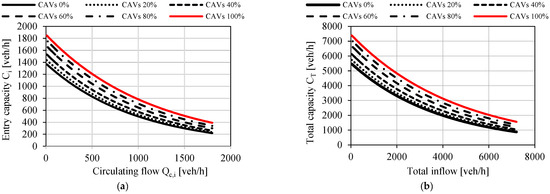
Figure 8.
Entry capacity (a) and total capacity (b) as a function of the proportion of CAVs in traffic stream for the matrix ρ1. Scenario a: bypass inactive (δ = 0).
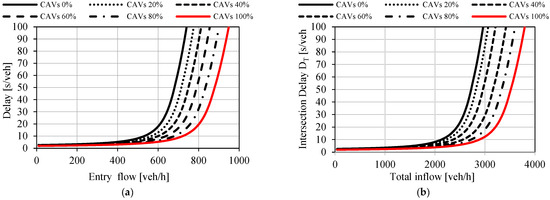
Figure 9.
Entry delay (a) and mean delay for the roundabout (b) as a function of the proportion of CAVs in traffic stream for the matrix ρ1. Bypass lanes inactive (δ = 0).
For instance, when circulating flow and total inflow are close to 0 veh/h, the entry capacity reaches the maximum values of 1380 veh/h and 1863 veh/h for CAVs = 0% and CAVs = 100%, respectively. Instead, the total capacity varies from 5465 veh/h to 7390 veh/h with the increase in CAVs percentage in the traffic flow range of 0–100%.
Similarly, for the scenario in which right-turn bypass lanes are active (scenario S5 of Table 1 and Figure 2b) which under the functional point of view corresponds to a flower-roundabout, Figure 10 and Figure 11 display the capacity and delay values assessed for each arm and for the whole SSF-roundabout for different percentages of CAVs in the vehicular flows and δi = 1. Figure 12 shows total capacity and mean delay for the matrix ρ1 as a function of the total inflow and various values of δ (CAVs = 100%)
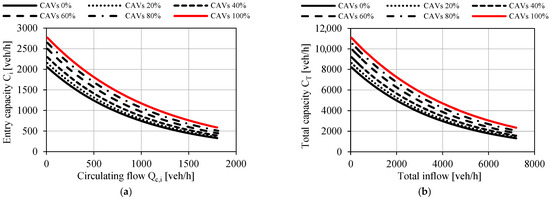
Figure 10.
Entry Capacity (a) and total capacity (b) as a function of the proportion of CAVs in traffic stream for the matrix ρ1. Scenario b: Bypass lanes active (δ = 1).
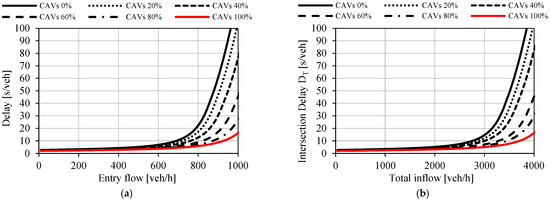
Figure 11.
Entry delay (a) and mean delay for the roundabout (b) as a function of the proportion of CAVs in traffic stream for the matrix ρ1. Bypass lanes active (δ = 1).
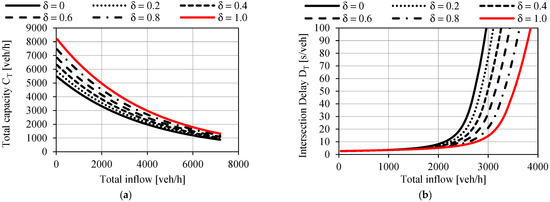
Figure 12.
Total capacity (a) and mean delay for the roundabout (b) for the matrix ρ1 as a function of the total inflow and δ (CAVs = 100%). Bypass lanes inactive.
Considering δi = 1, if entering flow QE,i and total inflow QE are close to 0 veh/h, the entry capacity reaches the maximum values of 2050 veh/h and 2770 veh/h for CAVs = 0% and CAVs = 100%, respectively. Instead, the total capacity varies from 8196 veh/h to 11,082 veh/h with the increase in CAVs percentage in the traffic flow, in the range of 0–100%.
Therefore, the activation of the right-turn bypass lanes may produce a capacity increase of DCi = (2770 − 1863)/1863∙100 = 48% and the total capacity increase of DCT = (11082 − 7390)/7390∙100 = 50% in the case of 100% of CAVs.
Similar results were obtained for the case of the traffic distribution matrix ρ2. As it is immediately clear from Figure 13, Figure 14, Figure 15 and Figure 16, the presence the activation of right-turn bypass lanes may produce a remarkable capacity increase and delay decrease, although less than in the case of matrix ρ2: DCi = (2367 − 1856)/1856∙100 = 28% and the total capacity increase of DCT = (9470 − 7422)/7422∙100 = 28% in the case of 100% of CAVs.
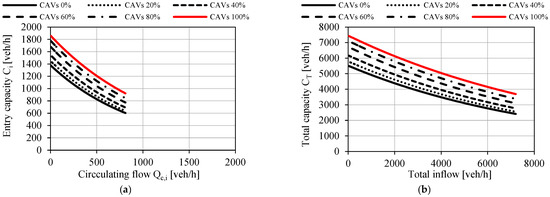
Figure 13.
Entry capacity (a) and total capacity (b) as a function of the proportion of CAVs in the traffic stream for the matrix ρ2. Scenario a: bypass lanes inactive (δ = 0).
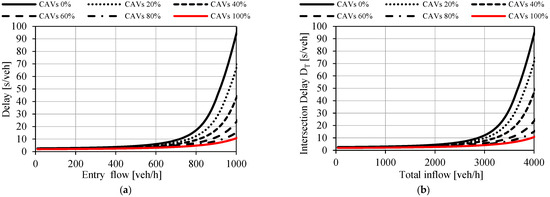
Figure 14.
Entry delay (a) and mean delay for the roundabout (b) as a function of the proportion of CAVs in the traffic stream for the matrix ρ2. Bypass lanes inactive (δ = 0).
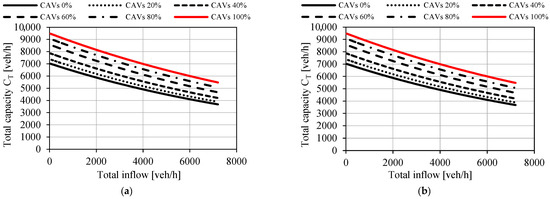
Figure 15.
Entry capacity (a)and total capacity (b) as a function of the proportion of CAVs in the traffic stream for the matrix ρ2. Scenario b: bypass lanes active (δ = 1).
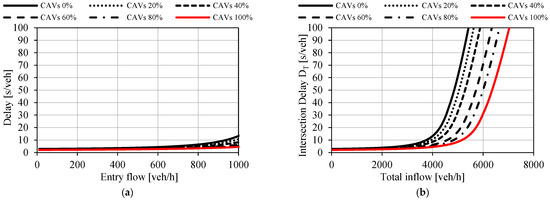
Figure 16.
Entry delay (a) and mean delay for the roundabout (b) as a function of the proportion of CAVs in the traffic stream for the matrix ρ2. Bypass lanes active (δ = 1).
The results of the traffic simulations highlight how the activation of the right-turn bypass lanes can determine benefits on the MOEs of the SSF-roundabout, for all the traffic demand conditions related to all the origin–destination traffic matrices obtained by varying Ei(t) and ρi (Equation (43)), and for every penetration rate of CAVs, the traffic flows. The activation of the right-turn bypass lanes is justified during the time intervals in which the traffic demand is intense. However, in this case, more conflict points and crash risks can be accepted in exchange for the benefits of simple and total capacity and lower control delays.
As demonstrated by the outcomes, when the right-turn bypass lanes are available, CAVs can increase the roundabout traffic capacity differently in the function of the distribution of the right-turn maneuvers between entering lanes and bypass lanes. In light of these considerations, a roundabout traffic manager and a traffic control system based on computer vision vehicle detection could be required to optimize vehicles’ trajectories and maximize capacity and safety and minimize traffic emissions both in traditional and smart roads [7,18,27,28,29,30,31,32,33].
7. Conclusions
Several research and practical applications demonstrate that single-lane roundabouts guarantee high road safety levels thanks to the lower number of conflict points and vehicle speeds compared to other at-grade road intersections. However, due to their relatively low capacity, single-lane roundabouts can be installed in a road network only in cases of low to medium traffic demand levels. To increase capacity, single-lane roundabout designs have often incorporated exclusive right-turn bypass lanes, as in the circumstance of the so-called Flower roundabout layout, but this solution generates more exit and entry traffic conflict points. In addition, the variations in traffic demand do not continuously make the use of right-turn lanes and bypass lanes necessary. Considering these issues, this research introduces the prototype SSF-roundabout, a novel smart and self-regulated roundabout in which right-turn bypass lanes at the arms can be activated or deactivated depending on the flows detected in real-time from traffic sensors. The SSF-roundabout implements traffic counting systems, smart cameras, LED road markers, and Variable Message Signs (VMS) to inform users and channel vehicles, or not, into the right-turn bypass lanes, depending on the instantaneous traffic demand. The SSF-roundabout may assume fifteen different layout configurations as a function of the combination of active and inactive bypass lanes at the four arms.
After introducing the traffic models for evaluating the performance of the novel SSF-roundabout, several simulations were performed by taking into account many origin–destination traffic matrices MO/D(t). Two very different test traffic distribution matrices were considered: the matrix ρ1 characterizes an identical distribution of the traffic into the roundabout, and the matrix ρ2 represents an unbalanced repartition of flows (at each entry, 15% of the entering flow crosses the roundabout, 70% turn right, and 15% turn left). Moreover, several proportions of CAVs in the traffic stream (from 0% to 100%) were considered in scenarios in which bypass lanes are active or inactive.
Results from simulations show that when entering flows increase, entry and total capacity of the SSF-roundabout decrease, and control delays increase, but the magnitude of this effect changes with the percentage of CAVs in the composition of flows. As a matter of fact, as this percentage increases, entry and total capacity growth and control delays are reduced, with additional benefits in terms of LOS. For instance, considering the traffic distribution matrix ρ1 and 100% of CAV, the activation of all the right-turn bypass lanes may produce a capacity increase DCi = 48% and the total capacity increase DCT = 50% concerning the scenario in which all the bypass lanes are inactive. It is worth underlining that the activation of the right-turn bypass lanes is acceptable only in the time intervals in which the traffic demand levels are severe. Otherwise, it is preferable to inactivate the right-turn bypass lanes to increase safety. The undeniable safety benefits of single-lane roundabouts should not be overlooked to increase capacity at intersections. To optimize the choice between improving capacity or safety, the SSF-roundabout offers an excellent solution by selectively activating additional turning lanes based on traffic demand thresholds and associated safety risks. This approach becomes even more effective with the growing penetration of CAVs, where vehicle control precision and behavioural patterns can be closely monitored and accurately predicted. The main limitation of this research is related to the fact that the SSF-roundabout is in the conceptual development phase; therefore, no real traffic data can be used for calibrating and validating the traffic analyses. Future studies could investigate the influence of the Traffic Manager System at SSF-roundabouts on CAVs. With the advancement of smartization across various sectors and the growing emphasis on developing smart cities, SSF-roundabouts could play a vital role in urban traffic management. In particular, the smart regulation systems proposed for the SSF-roundabouts, based on the use of traffic flow and queue length estimation in real-time and Variable Message Signs (VMS), could be used to convert traditional roundabouts equipped with bypass lanes, which, as stated in the article, may produce a greater accidents risk of than single-lane roundabouts due to their increased points of conflict. From this perspective, the proposed regulatory system would also make existing rotators smart, modulating their capacity and safety in response to measured traffic fluctuations, adjusting the roundabout’s behaviour in real time.
7.1. Limitations of the Study
This research has its limitations, which are encountered at various stages. The major limitation is that the SSF-roundabout is in the conceptual development stage; therefore, only closed-form capacity models have been applied. In addition, safety comparison with other well-known roundabout types is addressed only from a quality point of view (i.e., by analyzing only the number of conflict points) without crash frequency evaluations.
7.2. Research Perspectives
Despite the promising findings, additional studies are required to establish a more accurate estimation of capacity, delay, and queue in a broader range of traffic distribution conditions among arms. Moreover, future research must explore crash frequency evaluations by using specific Safety Performance Functions (SPFs) and Crash Modification Factors (CMFs) specifically fitted for the case of roundabouts equipped with right-turn bypass lanes.
Author Contributions
Conceptualization, M.G. and M.K.; methodology, M.G.; software, M.G.; formal analysis, M.G.; investigation, M.K.; writing—original draft preparation, M.G. and M.K.; writing—review and editing, M.G. and M.K.; supervision, M.G. All authors have read and agreed to the published version of the manuscript.
Funding
This research received no external funding.
Data Availability Statement
The original contributions presented in the study are included in the article. Further inquiries can be directed to the corresponding author.
Acknowledgments
The authors acknowledge the Italian Ministry of Universities and Research (MUR) in the framework of the project DICAM–EXC (Departments of Excellence 2023–2027, grant No. L232/2016).
Conflicts of Interest
The authors declare no conflicts of interest.
References
- Daniels, S.; Brijs, T.; Nuyts, E.; Wets, G. Extended prediction models for crashes at roundabouts. Saf. Sci. 2011, 49, 198–207. [Google Scholar] [CrossRef]
- Elvik, R. Road safety effects of roundabouts: A meta-analysis. Accid. Anal. Prev. 2017, 99, 364–371. [Google Scholar] [CrossRef] [PubMed]
- Robinson, B.W.; Rodegerdts, L.; Scarborough, W.; Kittelson, W.; Troutbeck, R.; Brilon, W.; Bondzio, L.; Courage, K.; Kyte, M.; Mason, J.; et al. Roundabouts: An Informational Guide; FHWA-RD-00-67; Federal Highway Administration, Turner-Fairbank Highway Research Center: McLean, VA, USA, 2000.
- USDOT. Automated Driving Systems: A Vision for Safety; U.S. Department of Transportation: Washington, DC, USA, 2019.
- Jiang, Q.; Schroeder, B.; Ma, J.; Rodegerdts, L.; Cesme, B.; Bibeka, A.; Morgan, A. Developing Highway Capacity Manual Capacity Adjustment Factors for Connected and Automated Traffic on Roundabouts. J. Transp. Eng. Part A Syst. 2022, 148, 04022014. [Google Scholar] [CrossRef]
- Zhao, L.; Malikopoulos, A.; Rios-Torres, J. Optimal control of connected and automated vehicles at roundabouts: An investigation in a mixed-traffic environment. IFAC-Pap. 2018, 51, 73–78. [Google Scholar] [CrossRef]
- Martin-Gasulla, M.; Elefteriadou, L. Single-Lane Roundabout Manager under Fully Automated Vehicle Environment. Transp. Res. Rec. 2019, 2673, 439–449. [Google Scholar] [CrossRef]
- Gill, V.; Kirk, B.; Godsmark, P.; Flemming, B. Automated Vehicles: The Coming of the Next Disruptive Technology; The Conference Board of Canada: Ottawa, ON, Canada, 2015. [Google Scholar]
- Wu, Y.; Zhu, F. Junction management for connected and automated vehicles: Intersection or roundabout? Sustainability 2021, 13, 9482. [Google Scholar] [CrossRef]
- Virdi, N.; Grzybowska, H.; Waller, S.T.; Dixit, V. A safety assessment of mixed fleets with Connected and Autonomous Vehicles using the Surrogate Safety Assessment Module. Accid. Anal. Prev. 2019, 131, 95–111. [Google Scholar] [CrossRef]
- Pilko, H.; Mandžuka, S.; Barić, D. Urban single-lane roundabouts: A new analytical approach using multi-criteria and simultaneous multi-objective optimization of geometry design, efficiency and safety. Transp. Res. Part C Emerg. Technol. 2017, 80, 257–271. [Google Scholar] [CrossRef]
- Tollazzi, T.; Rencelj, M.; Turnsek, S. New Type of Roundabout: Roundabout with “Depressed” Lanes for Right Turning—“Flower Roundabout”. Promet-Traffic Transp. 2011, 23, 353–358. [Google Scholar] [CrossRef]
- Lagoa, P.; Galvão, T.; Campos Ferreira, M. Variable Message Signs in Traffic Management: A Systematic Review of User Behavior and Future Innovations. Infrastructures 2024, 9, 184. [Google Scholar] [CrossRef]
- Anagnostopoulos, A.; Kehagia, F. CAVs and roundabouts: Research on traffic impacts and design elements. Transp. Res. Procedia 2020, 49, 83–94. [Google Scholar] [CrossRef]
- Chalaki, B.; Beaver, L.E.; Malikopoulos, A.A. Experimental Validation of a Real-Time Optimal Controller for Coordination of CAVs in a Multi-Lane Roundabout. In Proceedings of the IEEE Intelligent Vehicles Symposium, Las Vegas, NV, USA, 19 October–13 November 2020; pp. 775–780. [Google Scholar]
- Medina, A.; Bansen, J. Reasons for Drivers Failing To Yield at Multi-Lane Roundabout Exits: Transportation Pooled Fund Study Final Report; FHWA-HRT-23-023; United States Federal Highway Administration: McLean, VA, USA, 2023.
- Al-Ghandour, M.N.; Schroeder, B.J.; Williams, B.M.; Rasdorf, W.J. Conflict models for single-lane roundabout slip lanes from microsimulation: Development and validation. Transp. Res. Rec. 2011, 2236, 92–101. [Google Scholar] [CrossRef]
- Guerrieri, M.; Corriere, F.; Rizzo, G.; Lo Casto, B.; Scaccianoce, G. Improving the sustainability of transportation: Environmental and functional benefits of right turn by-pass lanes at roundabouts. Sustainability 2015, 7, 5838–5856. [Google Scholar] [CrossRef]
- Assolie, A.A.; Sukor, N.S.A.; Khliefat, I.; Abd Manan, T.S.B. Modeling of Queue Detector Location at Signalized Roundabouts via VISSIM Micro-Simulation Software in Amman City, Jordan. Sustainability 2023, 15, 8451. [Google Scholar] [CrossRef]
- TRUM. Traffic and Road Use Management; Department of Transport and Main Roads: Brisbane, QLD, Australia, 2022.
- Mauro, R. Calculation of Roundabouts: Capacity, Waiting Phenomena and Reliability; Springer: Berlin/Heidelberg, Germany, 2010. [Google Scholar]
- Siegloch, W. Die Leistungsermittlung an Knotenpunkten ohne Lichtsignalsteuerung (Capacity Evaluation at Unsignalized Intersections); Strassenbau und Strassenverkehrstechnik, no. 154; Bundesminister fuer Verkehr: Bonn, Germany, 1973. [Google Scholar]
- National Academies of Sciences, Engineering, and Medicine. Highway Capacity Manual: A Guide for Multimodal Mobility Analysis, 7th ed.; The National Academies Press: Washington, DC, USA, 2022. [Google Scholar]
- National Academies of Sciences, Engineering, and Medicine. Roundabouts: An Informational Guide, 2nd ed.; TRB, NCHRP Report 672; The National Academies Press: Washington, DC, USA, 2010. [Google Scholar]
- Tracz, M. Analysis of Small Roundabouts’ Capacity. In Proceedings of the National Roundabout Conference, Kansas City, MO, USA, 18–21 May 2008. [Google Scholar]
- Tracz, M.; Chodur, J.; Ostrowsk, K. Roundabouts Country report—Poland. In Proceedings of the 6th International Symposium on Highway Capacity and Quality of Service, Stockholm, Sweden, 28 June–3 July 2011. [Google Scholar]
- Guerrieri, M.; Pugno, N. ANTi-JAM solutions for smart roads: Ant-inspired traffic flow rules under CAVs environment. Transp. Res. Interdiscip. Perspect. 2025, 29, 101331. [Google Scholar] [CrossRef]
- Guerrieri, M.; Khanmohamadi, M. COM-Roundabout: The first smart commutable and self-regulating roundabout for HDVs and CAVs. Int. J. Transp. Sci. Technol. 2025. [Google Scholar] [CrossRef]
- Guerrieri, M.; Parla, G.; Corriere, F. A new methodology to estimate deformation of longitudinal safety barriers. ARPN J. Eng. Appl. Sci. 2013, 8, 763–769. [Google Scholar]
- Michailidis, P.; Michailidis, I.; Lazaridis, C.R.; Kosmatopoulos, E. Traffic Signal Control via Reinforcement Learning: A Review on Applications and Innovations. Infrastructures 2025, 10, 114. [Google Scholar] [CrossRef]
- Mauro, R.; Guerrieri, M. Comparative life-cycle assessment of conventional (double lane) and non-conventional (turbo and flower) roundabout intersections. Transp. Res. Part D Transp. Environ. 2016, 48, 96–111. [Google Scholar] [CrossRef]
- Guerrieri, M. Smart Roads Geometric Design Criteria and Capacity Estimation Based on AV and CAV Emerging Technologies. A Case Study in the Trans-European Transport Network. Int. J. Intell. Transp. Syst. Res. 2021, 19, 429–440. [Google Scholar] [CrossRef]
- Fernandes, P.; Tomás, R.; Acuto, F.; Pascale, A.; Bahmankhah, B.; Guarnaccia, C.; Granà, A.; Coelho, M.C. Impacts of roundabouts in suburban areas on congestion-specific vehicle speed profiles, pollutant and noise emissions: An empirical analysis. Sustain. Cities Soc. 2020, 62, 102386. [Google Scholar] [CrossRef]
Disclaimer/Publisher’s Note: The statements, opinions and data contained in all publications are solely those of the individual author(s) and contributor(s) and not of MDPI and/or the editor(s). MDPI and/or the editor(s) disclaim responsibility for any injury to people or property resulting from any ideas, methods, instructions or products referred to in the content. |
© 2025 by the authors. Licensee MDPI, Basel, Switzerland. This article is an open access article distributed under the terms and conditions of the Creative Commons Attribution (CC BY) license (https://creativecommons.org/licenses/by/4.0/).
